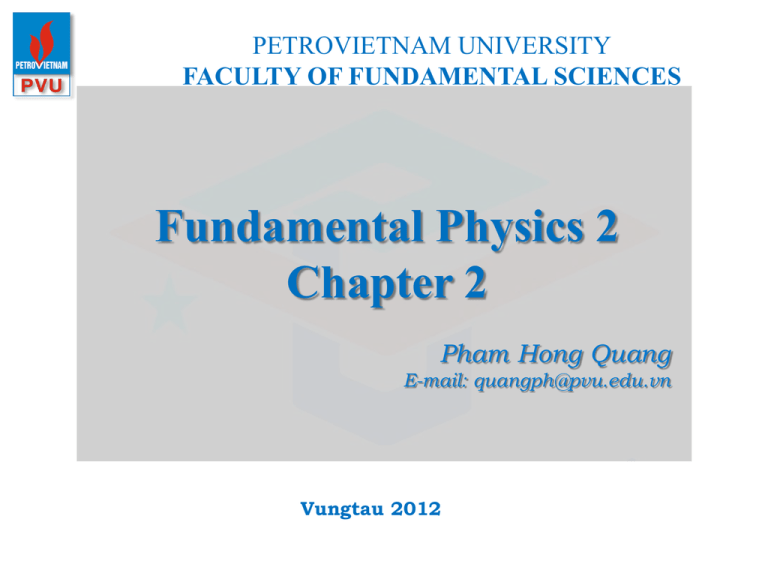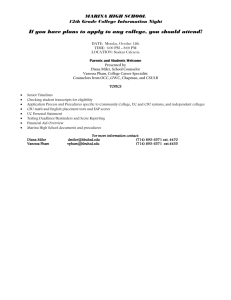Pham Hong Quang Faculty of Fundamental Sciences 2.9 Resistors
advertisement

PETROVIETNAM UNIVERSITY FACULTY OF FUNDAMENTAL SCIENCES Fundamental Physics 2 Chapter 2 Pham Hong Quang E-mail: quangph@pvu.edu.vn Vungtau 2012 CHAPTER 2 Capacitance , Current and Resistance, Direct Current Circuits Pham Hong Quang 2 PetroVietnam University 2 CHAPTER 2 2.1 Definition of Capacitance 2.2 Combinations of Capacitors 2.3 Energy Stored in a Charged Capacitor 2.4 Electric Current 2.5 The Resistance 2.6 Ohm’s law 2.7 Electric Power in Electric Circuits 2.8 Direct Current 2.9 Resistors in Series and Parallel 2.10 Kirchhoff ’s Rules Pham Hong Quang Faculty of Fundamental Sciences 3 2.1 Definition of Capacitance Definition of Capacitor A capacitor consists of 2 conductors of any shape placed near one another without touching. It is common; to fill up the region between these 2 conductors with an insulating material called a dielectric. We charge these plates with opposing charges to set up an electric field. Pham Hong Quang Faculty of Fundamental Sciences 4 2.1 Definition of Capacitance Electric Potential for Conducting Sheets E dA EA qenc o Q o Q A , EA A o E o Pham Hong Quang V E dr )dr a o a V (b) V (a ) ( )dr b o V (b) V (a ) (a b), a b d o Qd V d Ed o o A b V (b) V (a ) ( Faculty of Fundamental Sciences 5 2.1 Definition of Capacitance V Ed , V E , if d constant E Q Therefore Q V C contant of proportion ality C Capacitanc e Q CV Q C V The unit for capacitance is the FARAD, F. Pham Hong Quang Faculty of Fundamental Sciences 6 2.1 Definition of Capacitance The Capacitance of a parallel plate capacitor (1) Calculate q: (2) Calculate V (3) Calculate C: q 0 EA C V Ed Pham Hong Quang Faculty of Fundamental Sciences 7 2.1 Definition of Capacitance Dielectric Remember, the dielectric is an insulating material placed between the conductors to help store the charge. A C k o d k Dielectric dielectric constant k, which is the ratio of the field magnitude E0 without the dielectric to the field magnitude E inside the dielectric: Pham Hong Quang Faculty of Fundamental Sciences 8 2.2 Combinations of Capacitors Let’s say you decide that 1 capacitor will not be enough to build what you need to build.You may need to use more than 1. There are 2 basic ways to assemble them together Series – One after another Parallel – between a set of junctions and parallel to each other. Pham Hong Quang Faculty of Fundamental Sciences 9 2.2 Combinations of Capacitors Parallel Combination The total charge on capacitors connected in parallel is the sum of the charges on the individual capacitors for the equivalent capacitor Pham Hong Quang Faculty of Fundamental Sciences 10 2.2 Combinations of Capacitors If we extend this treatment to three or more capacitors connected in parallel, we find the equivalent capacitance to be Thus, the equivalent capacitance of a parallel combination of capacitors is the algebraic sum of the individual capacitances and is greater than any of the individual capacitances. Pham Hong Quang Faculty of Fundamental Sciences 11 2.2 Combinations of Capacitors Series Combination •The charges on capacitors connected in series are the same. •The total potential difference across any number of capacitors connected in series is the sum of the potential differences across the individual capacitors. Pham Hong Quang Faculty of Fundamental Sciences 12 2.2 Combinations of Capacitors When this analysis is applied to three or more capacitors connected in series, the relationship for the equivalent capacitance is the inverse of the equivalent capacitance is the algebraic sum of the inverses of the individual capacitances and the equivalent capacitance of a series combination is always less than any individual capacitance in the combination. Pham Hong Quang Faculty of Fundamental Sciences 13 2.3 Energy Stored in a Charged Capacitor The potential energy of a charged capacitor may be viewed as being stored in the electric field between its plates. Suppose that, at a given instant, a charge q′ has been transferred from one plate of a capacitor to the other. The potential difference V′ between the plates at that instant will be q′/C. If an extra increment of charge dq′ is then transferred, the increment of work required will be, Pham Hong Quang Faculty of Fundamental Sciences 14 2.3 Energy Stored in a Charged Capacitor The work required to bring the total capacitor charge up to a final value q is This work is stored as potential energy U in the capacitor, so that Pham Hong Quang Faculty of Fundamental Sciences 15 2.3 Energy Stored in a Charged Capacitor Energy Density The potential energy per unit volume between parallel-plate capacitor is V/d equals the electric field magnitude E Pham Hong Quang Faculty of Fundamental Sciences 16 2.4 Electric current Electric current I is the rate of the flow of charge Q through a cross-section A in a unit of time t. The SI unit for current is a coulomb per second (C/s), called as an ampere (A) Pham Hong Quang Faculty of Fundamental Sciences 17 2.4 Electric current Direction of current A current arrow is drawn in the direction in which positive charge carriers would move, even if the actual charge carriers are negative and move in the opposite direction. The direction of conventional current is always from a point of higher potential toward a point of lower potential— that is, from the positive toward the negative terminal. Pham Hong Quang Faculty of Fundamental Sciences 18 2.4 Electric current Current Density J • Current density is to study the flow of charge through a cross section of the conductor at a particular point • It is a vector which has the same direction as the velocity of the moving charges if they are positive and the opposite direction if they are negative. • The magnitude of J is equal to the current per unit area through that area element. Pham Hong Quang Faculty of Fundamental Sciences 19 2.4 Electric current Drift Speed When a conductor does not have a current through it, its conduction electrons move randomly, with no net motion in any direction. When the conductor does have a current through it, these electrons actually still move randomly, but now they tend to drift with a drift speed vd in the direction opposite that of the applied electric field that causes the current Here the product ne, whose SI unit is the coulomb per cubic meter (C/m3), is the carrier charge density Pham Hong Quang Faculty of Fundamental Sciences 20 2.5 The Resistance The resistance (R) is defined as the ratio of the voltage V applied across a piece of material to the current I through the material: R=V/i SI Unit of Resistance: volt/ampere (V/A)=ohm(Ω) Pham Hong Quang Faculty of Fundamental Sciences 21 2.5 the Resistance The Resistivity Resistivity of a material is: The unit of ρ is ohm-meter (Ωm): The conductivity σ of a material is Pham Hong Quang Faculty of Fundamental Sciences 22 2.5 the Resistance Calculating Resistance from Resistivity •Resistance is a property of an object. It may vary depending on the geometry of the material. •Resistivity is a property of a material. Pham Hong Quang Faculty of Fundamental Sciences 23 2.6 Ohm’s law Ohm’s law states that the current I through a given conductor is directly proportional to the potential difference V between its end points. Ohm ' s law : I V Ohm’s law allows us to define resistance R and to write the following forms of the law: V I ; R Pham Hong Quang V IR; Faculty of Fundamental Sciences V R I 24 2.7 Electric Power in Electric Circuits The amount of charge dq that moves from terminals a to b in time interval dt is equal to i dt. Its electric potential energy decreases in magnitude by the amount •The decrease in electric potential energy from a to b is accompanied by a transfer of energy to some other form. The power P VIt associated with that transfer is the rate of transfer d U/dt, P which is t Pham Hong Quang Faculty of Fundamental Sciences 25 2.7 Electric Power in Electric Circuits The transfer of electric potential energy to thermal energy The rate of electrical energy dissipation due to a resistance is Caution: • P=iV applies to electrical energy transfers of all kinds; •P=i2R and P=V2/R apply only to the transfer of electric potential energy to thermal energy in a device with resistance. Pham Hong Quang Faculty of Fundamental Sciences 26 2.8 Direct Current When the current in a circuit has a constant direction, the current is called direct current Most of the circuits analyzed will be assumed to be in steady state, with constant magnitude and direction Because the potential difference between the terminals of a battery is constant, the battery produces direct current The battery is known as a source of emf Pham Hong Quang Faculty of Fundamental Sciences 27 2.8 Direct Current Electromotive Force The electromotive force (emf), e, of a battery is the maximum possible voltage that the battery can provide between its terminals The battery will normally be the source of energy in the circuit The positive terminal of the battery is at a higher potential than the negative terminal We consider the wires to have no resistance Pham Hong Quang Faculty of Fundamental Sciences 28 2.8 Direct Current Internal Battery Resistance If the internal resistance is zero, the terminal voltage equals the emf In a real battery, there is internal resistance, r The terminal voltage, DV = e – Ir Use the active figure to vary the emf and resistances and see the effect on the graph Pham Hong Quang Faculty of Fundamental Sciences 29 2.8 Direct Current The emf is equivalent to the open-circuit voltage This is the terminal voltage when no current is in the circuit This is the voltage labeled on the battery The actual potential difference between the terminals of the battery depends on the current in the circuit Pham Hong Quang Faculty of Fundamental Sciences 30 2.8 Direct Current Load Resistance The terminal voltage also equals the voltage across the external resistance This external resistor is called the load resistance In the previous circuit, the load resistance is just the external resistor In general, the load resistance could be any electrical device These resistances represent loads on the battery since it supplies the energy to operate the device containing the resistance Pham Hong Quang Faculty of Fundamental Sciences 31 2.8 Direct Current Power The total power output of the battery is I V I This power is delivered to the external resistor (I 2 R) and to the internal resistor (I2 r) I R I r 2 Pham Hong Quang 2 Faculty of Fundamental Sciences 32 2.9 Resistors in Series and Parallel Resistors in Series When two or more resistors are connected end-to-end, they are said to be in series For a series combination of resistors, the currents are the same in all the resistors because the amount of charge that passes through one resistor must also pass through the other resistors in the same time interval The potential difference will divide among the resistors such that the sum of the potential differences across the resistors is equal to the total potential difference across the combination Pham Hong Quang Faculty of Fundamental Sciences 33 2.9 Resistors in Series and Parallel •The equivalent resistance has the same effect on the circuit as the original combination of resistors • Req = R1 + R2 + R3 + … •The equivalent resistance of a series combination of resistors is the algebraic sum of the individual resistances and is always greater than any individual resistance •If one device in the series circuit creates an open circuit, all devices are inoperative Pham Hong Quang Faculty of Fundamental Sciences 34 2.9 Resistors in Series and Parallel Resistors in Parallel •The potential difference across each resistor is the same because each is connected directly across the battery terminals •A junction is a point where the current can split •The current, I, that enters a point must be equal to the total current leaving that point I = I 1 + I 2 The currents are generally not the same Consequence of Conservation of Charge Pham Hong Quang Faculty of Fundamental Sciences 35 2.9 Resistors in Series and Parallel Equivalent Resistance 1 1 1 1 Req R1 R2 R3 The inverse of the equivalent resistance of two or more resistors connected in parallel is the algebraic sum of the inverses of the individual resistance The equivalent is always less than the smallest resistor in the group Pham Hong Quang Faculty of Fundamental Sciences 36 2.9 Resistors in Series and Parallel •In parallel, each device operates independently of the others so that if one is switched off, the others remain on •In parallel, all of the devices operate on the same voltage •The current takes all the paths The lower resistance will have higher currents Even very high resistances will have some currents •Household circuits are wired so that electrical devices are connected in parallel Pham Hong Quang Faculty of Fundamental Sciences 37 2.10 Kirchhoff’s Rules There are ways in which resistors can be connected so that the circuits formed cannot be reduced to a single equivalent resistor Two rules, called Kirchhoff’s rules, can be used instead Pham Hong Quang Faculty of Fundamental Sciences 38 2.10 Kirchhoff’s Rules Kirchhoff’s Junction Rule •The sum of the currents at any junction must equal zero Currents directed into the junction are entered into the -equation as +I and those leaving as -I A statement of Conservation of Charge •Mathematically, I 0 junction Pham Hong Quang Faculty of Fundamental Sciences 39 2.10 Kirchhoff’s Rules Kirchhoff’s Loop Rule •Loop Rule The sum of the potential differences across all elements around any closed circuit loop must be zero •Mathematically, V 0 closed loop Pham Hong Quang Faculty of Fundamental Sciences 40 2.10 Kirchhoff’s Rules More about the Loop Rule Traveling around the loop from a to b In (a), the resistor is traversed in the direction of the current, the potential across the resistor is – IR In (b), the resistor is traversed in the direction opposite of the current, the potential across the resistor is is + IR Pham Hong Quang Faculty of Fundamental Sciences 41 2.10 Kirchhoff’s Rules In (c), the source of emf is traversed in the direction of the emf (from – to +), and the change in the electric potential is +ε In (d), the source of emf is traversed in the direction opposite of the emf (from + to -), and the change in the electric potential is -ε Pham Hong Quang Faculty of Fundamental Sciences 42 2.10 Kirchhoff’s Rules Problem-Solving Strategy – Kirchhoff’s Rules Conceptualize Study the circuit diagram and identify all the elements Identify the polarity of the battery Imagine the directions of the currents in each battery Categorize Determine if the circuit can be reduced by combining series and parallel resistors If so, proceed with those techniques If not, apply Kirchhoff’s Rules Pham Hong Quang Faculty of Fundamental Sciences 43 2.10 Kirchhoff’s Rules Analyze Assign labels and symbols to all known and unknown quantities Assign directions to the currents The direction is arbitrary, but you must adhere to the assigned directions when applying Kirchhoff’s rules Apply the junction rule to any junction in the circuit that provides new relationships among the various currents Pham Hong Quang Faculty of Fundamental Sciences 44 2.10 Kirchhoff’s Rules Analyze, cont Apply the loop rule to as many loops as are needed to solve for the unknowns To apply the loop rule, you must choose a direction in which to travel around the loop You must also correctly identify the potential difference as you cross various elements Solve the equations simultaneously for the unknown quantities Finalize Check your numerical answers for consistency If any current value is negative, it means you guessed the direction of that current incorrectly The magnitude will still be correct Pham Hong Quang Faculty of Fundamental Sciences 45 Thank you! Pham Hong Quang 46 PetroVietnam 46



